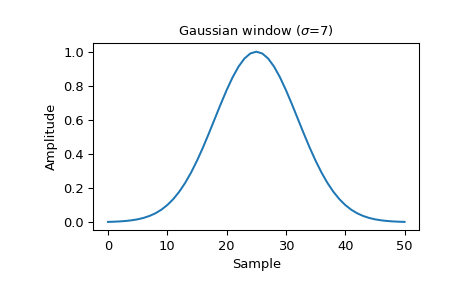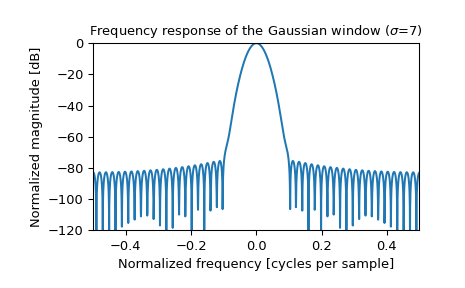scipy.signal.windows.gaussian#
- scipy.signal.windows.gaussian(M, std, sym=True)[source]#
Return a Gaussian window.
- Parameters
- Mint
Number of points in the output window. If zero or less, an empty array is returned.
- stdfloat
The standard deviation, sigma.
- symbool, optional
When True (default), generates a symmetric window, for use in filter design. When False, generates a periodic window, for use in spectral analysis.
- Returns
- wndarray
The window, with the maximum value normalized to 1 (though the value 1 does not appear if M is even and sym is True).
Notes
The Gaussian window is defined as
\[w(n) = e^{ -\frac{1}{2}\left(\frac{n}{\sigma}\right)^2 }\]Examples
Plot the window and its frequency response:
>>> from scipy import signal >>> from scipy.fft import fft, fftshift >>> import matplotlib.pyplot as plt
>>> window = signal.windows.gaussian(51, std=7) >>> plt.plot(window) >>> plt.title(r"Gaussian window ($\sigma$=7)") >>> plt.ylabel("Amplitude") >>> plt.xlabel("Sample")
>>> plt.figure() >>> A = fft(window, 2048) / (len(window)/2.0) >>> freq = np.linspace(-0.5, 0.5, len(A)) >>> response = 20 * np.log10(np.abs(fftshift(A / abs(A).max()))) >>> plt.plot(freq, response) >>> plt.axis([-0.5, 0.5, -120, 0]) >>> plt.title(r"Frequency response of the Gaussian window ($\sigma$=7)") >>> plt.ylabel("Normalized magnitude [dB]") >>> plt.xlabel("Normalized frequency [cycles per sample]")

